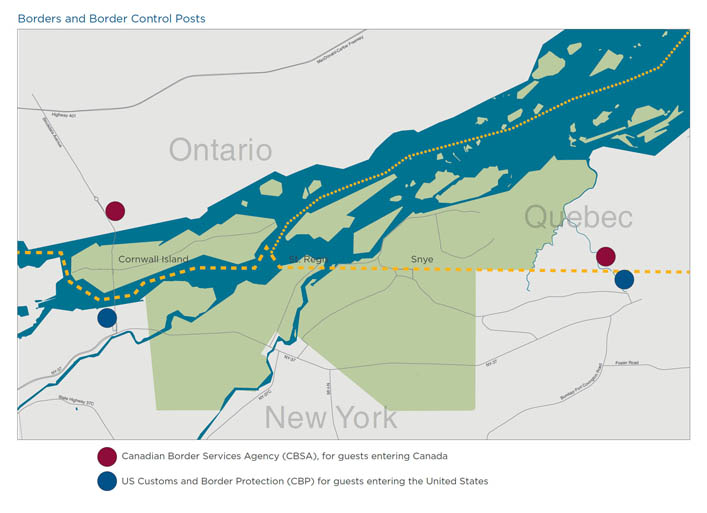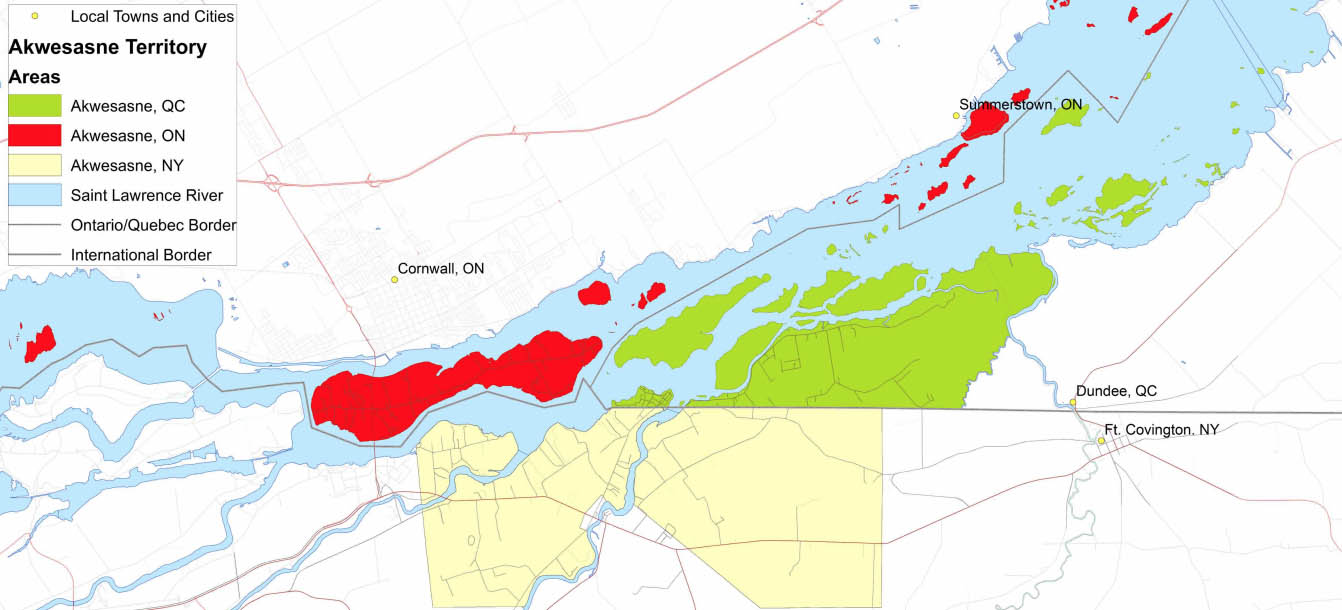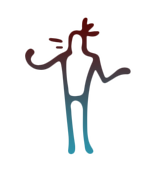
Travel Information



Travel Information
Indigenous artists, river recreation, local foods, and cultural events: Akwesasne isn’t your big city or nature retreat. It’s a special place with a creative soul, and we’re excited to connect with you. Plan your trip by checking out how to get here, things to do, and places to eat and stay.
Don’t hesitate to contact us with any questions, we would be happy to connect you with a guide during your visit.
The Mohawk Territory is situated on the international border between Canada and the United States and can be accessed from either country. Public transportation is limited on the Akwesasne Mohawk Territory, so we suggest you bring your own vehicle or come as a part of a small group tour.
While you are on Akwesasne Mohawk Territory, you will often cross between the USA and Canada. It is important to report to the appropriate customs agency at each border crossing, details are provided below.
Coming from Ontario, Canada
To the United States: Pass through the Three Nations Crossing connecting the City of Cornwall, Ontario and Massena, New York, via the Seaway International Bridge. There is a nominal fee to cross and rates can be found here.
To St. Regis or Snye (Quebec): The unique geography of Akwesasne requires that visitors cross into the United States through Three Nations Crossing at the Seaway International Bridge, and then drive over the international border within the Mohawk Territory to get from the United States to Kanatakon (St. Regis Village) and/or Tsi Snaihne (Snye), Quebec. There is a nominal fee to cross and you can find rates here.
It is important to note that once you cross from Ontario, Canada to the United States, there are no staffed border crossings into Kanatakon (St. Regis Village) and Tsi Snaihne (Snye), but you must report your crossings regardless. This can be done when you return through the Three Nations Crossing, or at the staffed border post in Fort Covington/Dundee, reachable by Quebec Route 132 on the Canadian side and by Dundee Road on the U.S. side.
Coming from the United States
To Ontario, Canada: Pass through the Three Nations Crossing connecting Massena, New York and the City of Cornwall, Ontario via the Seaway International Bridge. There is a nominal fee to cross and you can find rates here.
To St. Regis or Snye (Quebec): There are no staffed border crossings from the U.S. side of Akwesasne (New York) to Kanatakon (St. Regis Village) and Tsi Snaihne (Snye), Quebec, but you must report your crossings regardless. This can be done at the staffed border post in Fort Covington/Dundee, reachable by Quebec Route 132 on the Canadian side and by Dundee Road on the American side.
To Cornwall Island: Visitors are required to report directly to the Canada Border Services Agency (CBSA) border crossing in the City of Cornwall at the northern span of the Seaway International Bridge, even if you must drive past the Cornwall Island turnoff. You have officially entered Canada and must present yourself at the border crossing. This is required under the Immigration and Refugee Protection Act and the Customs Act. There is a nominal fee to cross and you can find rates here.
Once you have been processed by the CBSA, you will then be able to continue to your destination. Individuals who fail to report directly to the CBSA upon entering Canada and proceed directly to Cornwall Island will be subject to appropriate enforcement policies and sanctions.


At times, events cause an increase in traffic and border wait times. Plan to add some additional travel time to your itinerary to account for increased traffic volumes if traveling at rush hour or around event times.
To help speed up your border crossing and keep wait times low, we encourage you to:
- Have proper identification for you and your family readily available. Acceptable forms of identification include a passport or a NEXUS card.
- Plan ahead, download the CanBorder digital app and check the wait times online.
- Make sure your purchases or items coming into Canada or the United States are not on a list of prohibited goods.
- Pay attention to organic products among your goods. Declare any foods, plants, animals or other products such as untreated wood to the border services officer.
- Know that if traveling with pets, dogs and cats need valid signed and dated certificates from a veterinarian verifying vaccinations against rabies more than 30 days prior.
- Declare all money or currency equal to or over USD/CAN$10,000. It is not illegal to bring such amounts, but you must declare it on arrival.
- Know that if you have been convicted of a crime, including driving while impaired by alcohol or drugs, you may not be allowed to cross between countries.
- Register and declare firearms or weapons. Failure to do so means border services officers may seize the weapons, and file criminal charges. Most weapons are prohibited from entering Canada, including tasers.
- It is important to note that despite the fact that cannabis (marijuana) is legal and regulated in Canada, it remains illegal to take cannabis across Canada’s national borders, whether you are entering or leaving Canada.
For more information:
https://www.cbsa-asfc.gc.ca/menu-eng.html
https://www.cbp.gov/travel/us-citizens/know-before-you-go
General visitor guidelines:
- Please be attentive to signage, and obey our individual tribal rules and regulations.
- Weapons, drugs, and misuse of alcohol will not be tolerated.
- Please respect the privacy of residential communities.
- Ask before photographing or recording an individual, event or activity.
- Do not pick up or remove artifacts or objects.
- Burial grounds and religious ceremonies are sacred and are not to be entered.
There are several guidelines that you should know as a courtesy to the Powwow participants:
- Powwows are fun events, but they are also sacred events. Ceremonial songs and dances, which are sacred, are performed from time to time throughout the powwow.
- People should stand during all ceremonial songs and dances. These include the Grand Entry, Flag Songs, Veteran Songs, Honor Songs, and any other songs that the M.C. designates as a ceremonial song. Please stand quietly out of respect and always remove your hat/headgear.
- People should listen to the M.C. as he will announce the different songs and will also let people know when they can dance and when they cannot. He will also give you other information and news.
- Do not take any photos, videos or sound recordings of ceremonies without prior permission from the person or group you are recording. Some areas of Turtle Island do not allow the recording of ceremonies. Photography is permitted only at certain times; listen to the M.C. for details. If you would like to photograph individuals, please ask them for their permission first and respect their decision.
- The dancers wear “regalia” while they are dancing, NOT “costumes.” People should not touch the regalia. Never pick up a piece of a dancer’s outfit. Point out the item to the dancer and they will retrieve it.
- No Dogs are Allowed on the powwow grounds except for service animals.
- Do not walk across the dance arena, the chairs around the dance arena are for the dancers. You can bring your own chairs, or there are bleachers for you to sit in.
- Respect the Elders, Drummers, Singers, Dancers, and the Powwow staff and Committee
We encourage to Buy Local Buy Akwesasne. To ensure that you are buying authentic art from our local artists and craftspeople, following these buying tips:
- Request a written guarantee or written verification of authenticity
- Get a receipt that includes all the vital information about your purchase, including price, maker and maker’s Tribal affiliation
- Authentic handmade pieces may be expensive due to the time involved and the materials used. If a price seems too good to be true, be sure to ask more questions about the item and its maker to ensure its authenticity.
Akwesasne straddles the USA and Canada borders and spans both New York State and the Canadian provinces of Ontario and Quebec on both banks of the St. Lawrence River.






